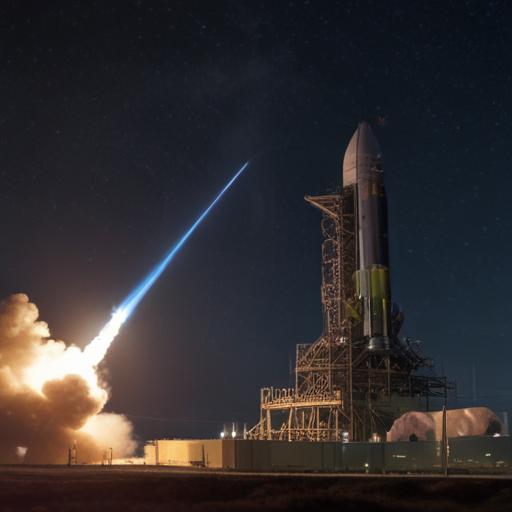Space fans on Florida’s Space Coast were awaiting a post-sunset liftoff of United Launch Alliance’s Vulcan rocket on the USSF-106 mission from Cape Canaveral Space Force Station’s Launch Complex 41.
ULA is targeting 8:56 p.m. to launch a 202-foot Vulcan rocket equipped with four solid rocket boosters for a Space Force national-security mission conducted by Space Systems Command. The launch will send the VC4S variant of Vulcan on an easterly trajectory, with the primary payload provided by L3Harris as Navigation Technology Satellite-3 (NTS-3).
Weather and forecaster notes painted a cautiously optimistic picture. The Space Force’s 45th Weather Squadron projected an 80% go for launch, citing scattered cumulus clouds and a low-to-moderate risk from solar activity. Officials stressed that no Brevard County sonic booms should occur and that conditions were being monitored closely as liftoff approached. Just days ahead, NASA-issued lightning warnings in a nearby area were monitored, but Cape Canaveral’s launch site remained green for launch.
As the countdown progressed, ULA’s updates highlighted key pre-liftoff steps. Weather balloons were launched to sample upper-atmosphere winds, with the data transmitted to engineers in Denver to help select a steering profile that minimizes aerodynamic and structural loads during ascent. In the early evening, ULA released footage of the Vulcan stack at Cape Canaveral, followed by a cutaway view of the vehicle’s two-stage configuration for the USSF-106 mission. The company described the Vulcan as blending elements from legacy Atlas V and Delta IV Heavy designs to meet national-security, commercial, and civil-launch needs.
L3Harris, the prime contractor for NTS-3, took center stage in the program’s narrative. The company’s role extends beyond the payload itself to spacecraft avionics and subsystems. NTS-3 marks the two-year anniversary of L3Harris’s acquisition of Aerojet Rocketdyne, a milestone reflected in the propulsion and thrust system that powers the mission’s upper stages. The Centaur V upper stage uses two Aerojet Rocketdyne RL10 engines delivering about 48,000 pounds of thrust, complemented by 12 MR-107 thrusters and helium systems supplied by L3Harris. In addition, L3Harris Integrated Mission Systems provides vital flight avionics, controllers, data acquisition units, and other data-relay hardware essential for vehicle control and mission data handling. NTS-3 is planned for deployment into near-geosynchronous orbit, contributing to navigation technology for the Space Force and broader space operations.
Fueling for the Centaur upper stage was nearing completion in the final minutes of the countdown, with topping modes underway to ensure a fully fueled vehicle for launch. Ground teams reported liquid hydrogen transfer in progress, and they noted a green readiness board with no outstanding issues as liftoff time approached. By 7:40 p.m., teams had confirmed that cryogenics would be replenished throughout the countdown to account for boil-off, ensuring stable propulsion for the ascent.
Ground observers also benefited from practical visibility estimates released by ULA, which mapped potential spectator visibility along Florida’s eastern coast from liftoff through the initial ascent. The company’s latest countdown briefing pegged liftoff at 8:56 p.m. with James Whelan, the launch director, at the helm.
As the moment neared, Brevard County Emergency Management activated its launch operations team to support the event, underscoring the community-wide coordination that accompanies major national-security launches. The night’s events will be webcast by ULA about 20 minutes before liftoff, with coverage synchronized to the countdown clock.
If the launch proceeds as planned, it will underscore the U.S. space industrial base’s ability to deliver advanced national-security capabilities while showcasing the Vulcan rocket’s versatility for both government and commercial missions. The collaboration among ULA, Space Systems Command, L3Harris, and Aerojet Rocketdyne reinforces the United States’ ongoing capacity to execute complex orbital missions from Cape Canaveral.
Summary: A high-profile post-sunset launch of the Vulcan rocket on USSF-106 from Cape Canaveral involves the NTS-3 satellite built by L3Harris, with the rocket’s propulsion and avionics integration supported by Aerojet Rocketdyne and L3Harris teams. Weather conditions were favorable for a launch, preliminary data collection from upper-atmosphere wind measurements supported a safe ascent plan, and observers were tracking every step of the countdown to a potential 8:56 p.m. liftoff.
Final note: This mission exemplifies the ongoing collaboration between U.S. government space needs and industry, aiming to enhance navigation technology and space operations capabilities for national security and broader scientific and civil users.
